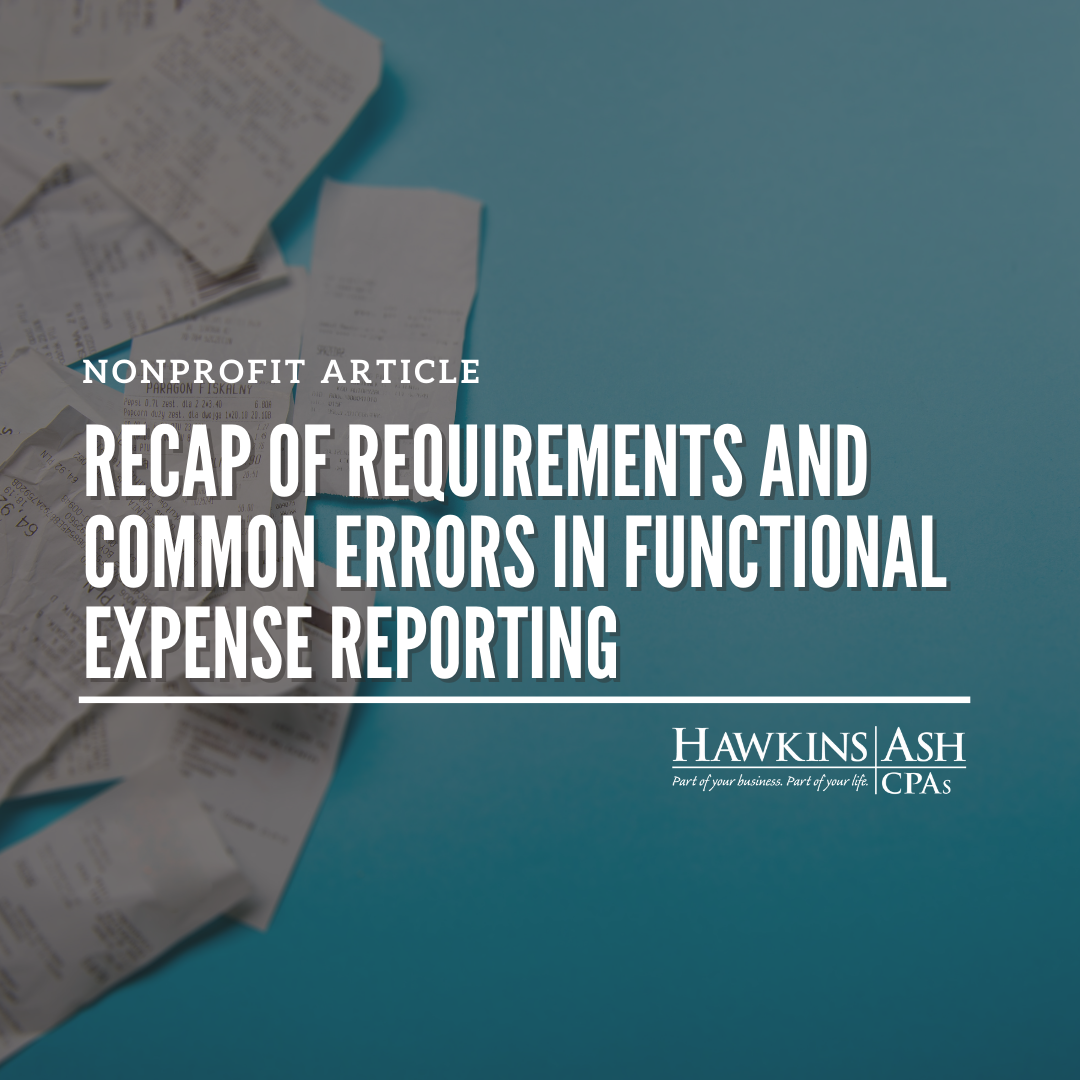With the implementation of FASB Accounting Standards Update 2016-14 several years ago many organizations were introduced to the concept of functional expense reporting. Now that we are a few years out from implementation, it is helpful to take a look back at the concepts and ensure your organization is properly reporting your functional expenses.
Functional Expense Categories
According to FASB 958-720-45, functional expenses are broken up into the following main categories:
-
- Program Services: Activities that result in goods and services being distributed to beneficiaries, customers, or members that fulfill the purposes or mission for which the NFP exists. Those services are the major purpose for and the major output of the NFP and often relate to several major programs.
- Management and General Activities: Supporting activities that are not directly identifiable with one or more program or fundraising development. Examples include oversight, business management, general recordkeeping and payroll, budgeting, financing, administrating customer contracts, and human resources management. The costs of oversight and management usually include the salaries and expenses of the governing board, the chief executive officer of the NFP, and the supporting staff. If such staff spend a portion of their time directly conducting or supervising program services or categories of other supporting services, however, their salaries and expenses shall be allocated among those functions.
- Fundraising Activities: Involve enticing potential donors to contribute money, securities, services, materials, facilities, other assets, or time. Examples include publicizing and conducting fundraising campaigns, maintaining donor mailing lists, conducting special fundraising events and preparing and distributing fundraising manuals, instructions, and other materials.
Allocation of Expenses
Most organizations accounting systems will track expenses by their natural classification but many are not set up to report into the three categories described above, therefore, allocations are often utilized to report costs for functional expense reporting purposes.
Some common expenses that need to be allocated are salaries/wages, benefits, occupancy costs including rent, utilities, insurance, repairs and maintenance and deprecation. There are a few different methodologies you can use to allocate costs. One methodology is based on employee time which may require a time study. Time studies can be as elaborate as having each individual track their time daily through a time management system or hiring an outside contractor to conduct a time study for each functional category. Less elaborate time studies can be as simple as picking a “representative” one week to one month in the year and having each employee track their time daily to each functional category. A “representative” period of time is one that is similar to what is done year-round. A common method for allocating expenses pertaining to space/occupancy would be to allocate based on square footage.
The key is to ensure you document the methodologies that you use and that there is some basis behind your methodologies. You should also review your cost allocation plan annually at a minimum.
Common Errors
A recent article published by the AICPA Center for Plain English details some common areas of noncompliance in not-for-profit functional expense reporting. These common errors include the following:
-
- NFPs with contribution revenues reporting no fundraising expenses. In some situations, this may be true. However, if your NFP is bringing in contribution revenue, there is more than likely some resources of the organization being used in an effort to bring in this revenue.
- Fundraising function includes salaries but no benefits or occupancy-related costs such as utilities, rent, or telephone. Generally, if you have employee expenses being allocated to the fundraising function, the general overhead expenses of the organization should also be allocated.
- Depreciation expense not allocated to functional expense categories. Depreciation expenses need to be allocated to their appropriate function, if assets are being utilized for program and supporting activities.
- Incorrect presentation of functional expenses. All NFPs are required to report all expenses by both functional and natural classification (these are mutually exclusive and shouldn’t be intermixed), in one location either on the face of the statement of activities, as a schedule in the notes to financial statements (not a supplementary schedule) or in a separate financial statement. The presentations should report the relationship between functional expense classifications, essentially answering the question, “why were the costs incurred?”
Importance of Proper Reporting
The overall intention of functional expense reporting is to help donors, creditors, and other users of your financial statements see your NFP’s service efforts and how you are utilizing your resources. It is important that expenses are reported properly so the users of your financial statements are able to reach reasonable and useable conclusions.
If you have other questions regarding the functional expense reporting requirements, please contact your Hawkins Ash CPAs representative.





